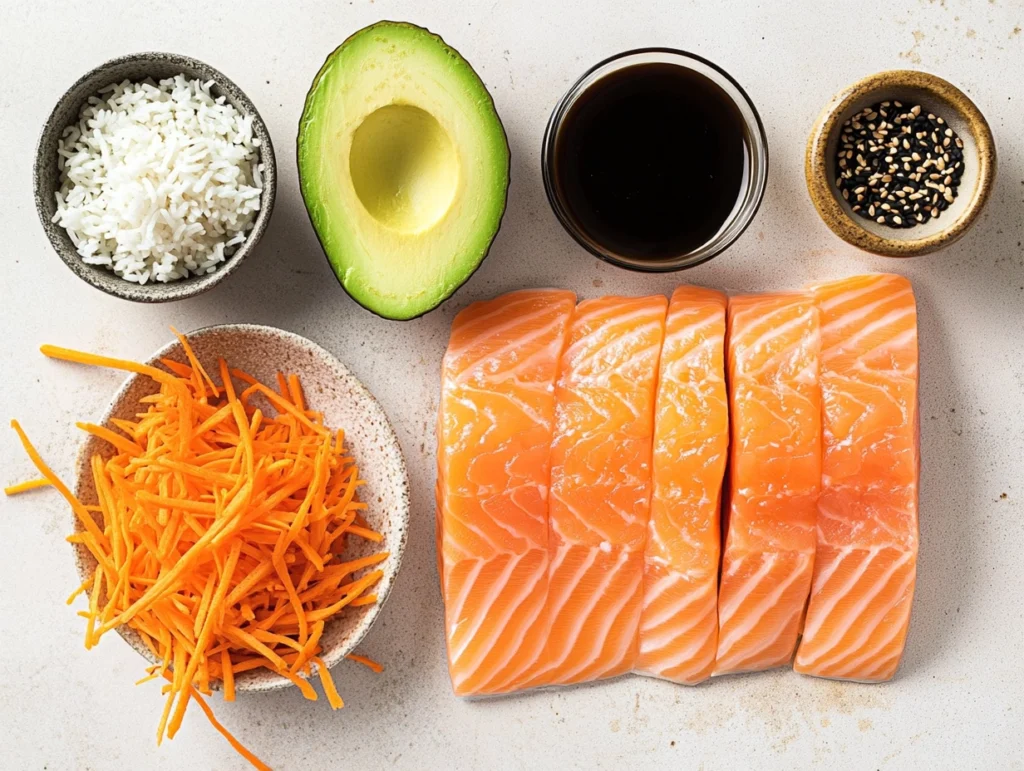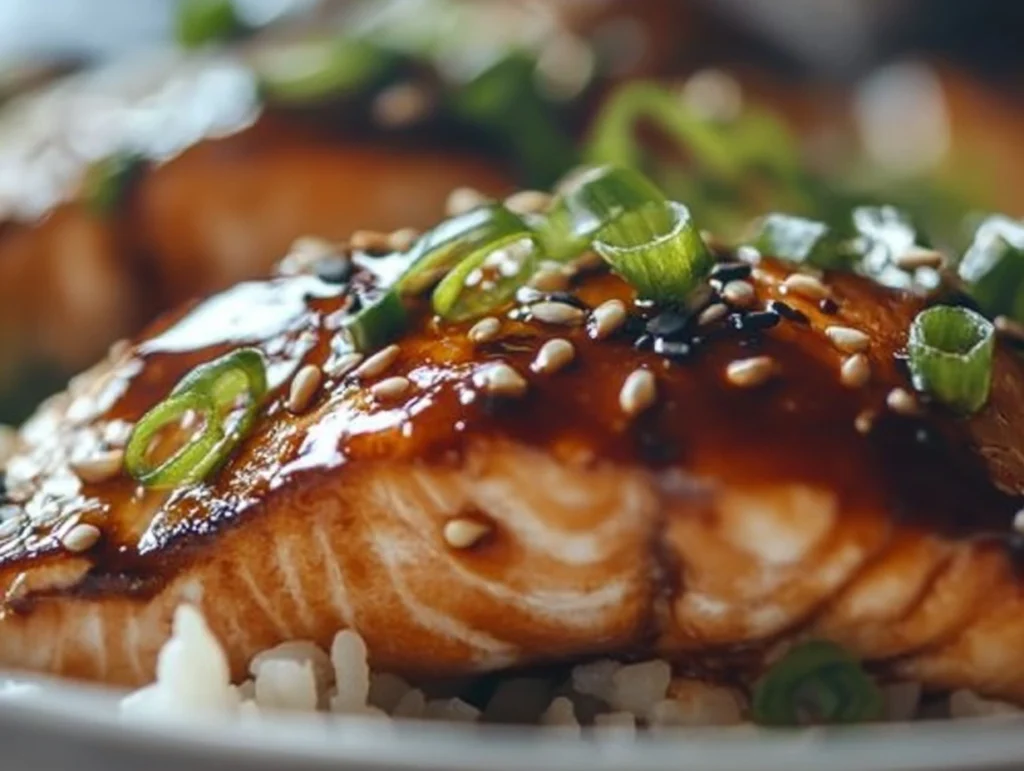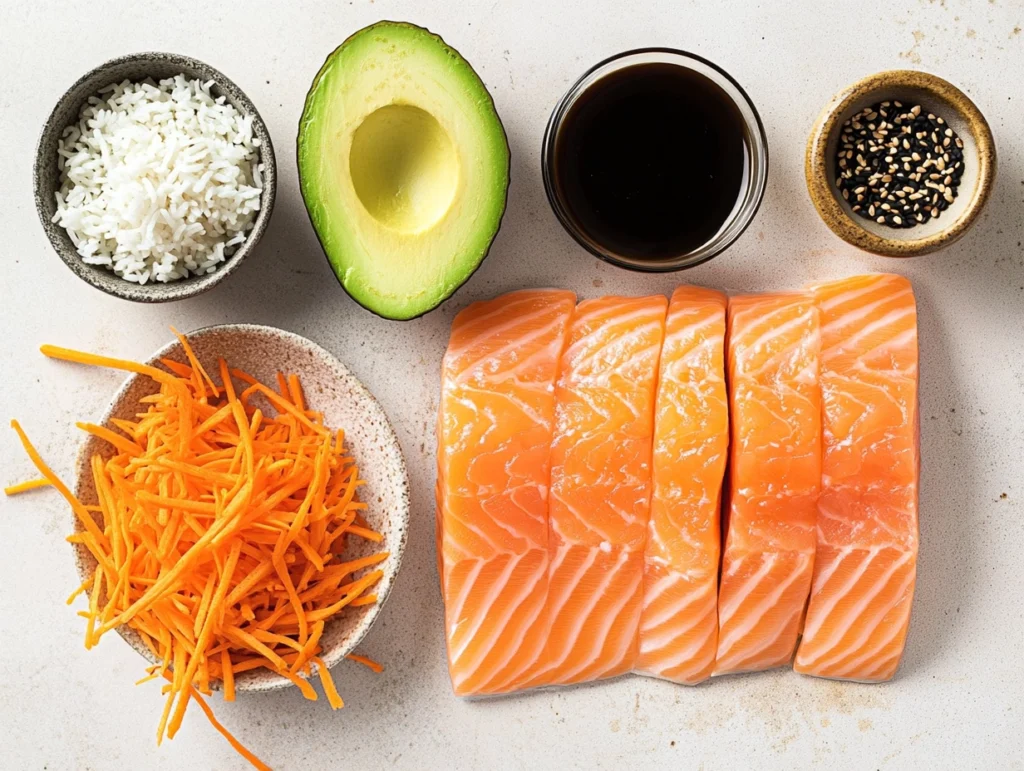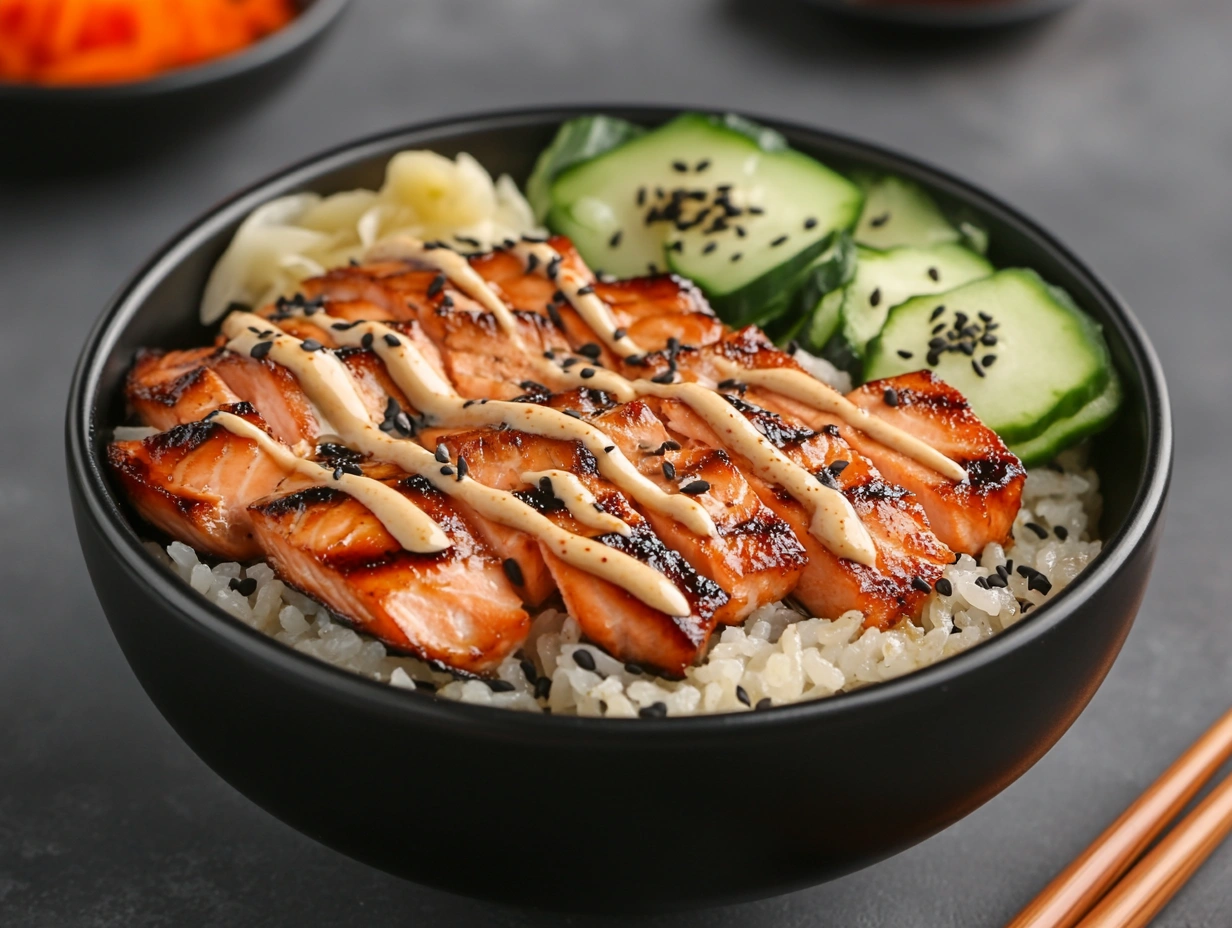Table of contents
- 1. Introduction
- 2. History and Cultural Significance of Salmon Rice Bowls
- 3. Health Benefits of Salmon and Rice
- 4. Flavor Pairing: Why Salmon and Rice Complement Each Other
- 5. Types of Salmon Rice Bowls Across Cultures
- 6. Essential Components of a Perfect Salmon Rice Bowl
- 7. Best Sauces for Salmon Rice Bowls
- 8. Step-by-Step Guide to Making Salmon Rice Bowls at Home
- 9. Nutritional Analysis
- 10. FAQs
- 11. Conclusion
1. Introduction
A salmon rice bowl is more than just a meal—it’s a fusion of taste, nutrition, and versatility. This dish has gained popularity worldwide, becoming a go-to option for health-conscious eaters, busy professionals, and food enthusiasts alike. Its appeal lies in its balance of flavors, textures, and customizable components.
Drawing inspiration from cuisines like Japanese and Hawaiian, the salmon rice bowl brings together tender salmon, fluffy rice, and an array of fresh toppings. Whether it’s a quick weekday dinner or a meal prep staple, this dish fits perfectly into any lifestyle.
In this guide, we’ll explore everything you need to know about the salmon rice bowl: its history, health benefits, variations, and how to make one that’s truly your own.

A delicious and healthy salmon rice bowl featuring fresh ingredients and vibrant colors.
2. History and Cultural Significance of Salmon Rice Bowls
2.1 Japanese Culinary Roots
The origins of the salmon rice bowl can be traced back to Japan’s beloved Donburi dishes. Donburi refers to rice bowls topped with various proteins and vegetables, often seasoned with sauces that enhance the natural flavors of the ingredients. In this context, salmon became a favorite due to its rich, umami flavor and versatility.
Salmon is a celebrated ingredient in Japanese cuisine, often appearing in dishes like sushi, sashimi, and grilled entrees. Its inclusion in rice bowls made it accessible as a hearty, nourishing meal. Whether served raw as Sake Don or cooked with teriyaki sauce, salmon has remained a cornerstone of Japanese culinary traditions.
2.2 Evolution in Hawaiian Cuisine
Hawaiian cuisine also played a significant role in the evolution of the salmon rice bowl, particularly through the creation of poke bowls. These vibrant dishes feature cubed, marinated raw fish, typically served over a bed of rice. While tuna is a common choice, salmon’s buttery texture and mild taste make it an equally popular option.
In Hawaii, rice bowls like poke are often seasoned with soy sauce, sesame oil, and seaweed, reflecting the island’s blend of Asian and Pacific Islander culinary influences. Over time, these flavors spread globally, inspiring new interpretations of the salmon rice bowl.
2.3 Modern Global Adaptations
Today, the salmon rice bowl has become a global phenomenon. It’s no longer confined to traditional recipes, evolving to include diverse ingredients like quinoa, avocado, and spicy sauces. Western adaptations have turned this dish into a staple for meal preppers and foodies alike.
This fusion of traditional and modern elements makes the salmon rice bowl a timeless favorite that caters to various dietary preferences and flavor profiles.
3. Health Benefits of Salmon and Rice
3.1 Nutritional Profile of Salmon
Salmon is a powerhouse of nutrition, making it a standout ingredient in any dish. It is particularly renowned for its high Omega-3 fatty acid content, which supports heart health, reduces inflammation, and enhances brain function. A single serving of salmon provides an impressive dose of high-quality protein, aiding in muscle repair and growth.
Additionally, salmon is rich in essential vitamins such as Vitamin D, crucial for bone health, and B12, which supports energy production and neurological function. Minerals like selenium and potassium further contribute to immunity and cardiovascular health.
Salmon’s Omega-3 fatty acids are essential for heart and brain health. Learn more about the benefits of Omega-3 fatty acids
3.2 Nutritional Profile of Rice
Rice, the foundational element of the dish, is a versatile carbohydrate source that provides sustained energy. White rice offers a quick energy boost due to its simple carbohydrate structure, while brown rice adds dietary fiber, magnesium, and antioxidants to the mix.
Brown rice is often favored for its ability to support digestion and provide a steadier energy release. Regardless of the type chosen, rice serves as a neutral yet nourishing base that pairs perfectly with the rich flavors of salmon.
3.3 Combined Health Benefits
When combined, salmon and rice form a nutritionally balanced meal. The high protein content from salmon complements the carbohydrates in rice, creating a dish that provides energy, satiety, and muscle recovery.
Moreover, this pairing is rich in essential amino acids, healthy fats, and fiber, making it suitable for various dietary needs. Whether you’re fueling a workout or seeking a wholesome lunch, the salmon rice bowl is a fantastic choice.
Is salmon and rice healthy? Absolutely! This dish offers an excellent combination of taste, texture, and nutrition that supports a healthy lifestyle.
4. Flavor Pairing: Why Salmon and Rice Complement Each Other
4.1 Taste Profiles
The magic of a salmon rice bowl lies in the harmony of its flavors. Salmon’s umami richness and natural oils bring depth and complexity to the dish. Its slight sweetness and smoky notes, especially when grilled or roasted, are perfectly balanced by the mild, comforting taste of rice.
Rice acts as a neutral canvas, absorbing the juices and seasonings from the salmon and sauces. Together, they create a flavorful experience that is both satisfying and versatile.
4.2 Textural Harmony
Texture is another reason why salmon and rice are a winning duo. The flaky, tender texture of cooked salmon contrasts beautifully with the soft, sticky consistency of steamed rice. Raw salmon, as in poke bowls or sashimi-style rice bowls, offers a buttery smoothness that pairs wonderfully with the firm yet pliable texture of sushi rice.
This interplay of textures elevates the eating experience, making every bite a delightful mix of softness, flakiness, and richness.
4.3 Cultural Perspectives
Across various cuisines, salmon and rice are celebrated for their compatibility. In Japanese dishes like Sake Don, the pairing highlights the natural flavors of the ingredients without overpowering them. In Hawaiian poke bowls, the duo serves as a foundation for vibrant toppings and dressings.
Why do salmon and rice go so well together? It’s a combination of complementary flavors, balanced textures, and cultural traditions that make this pairing a global favorite.
5. Types of Salmon Rice Bowls Across Cultures
5.1 Japanese Variations
Japan is a pioneer in rice bowl creations, and the salmon rice bowl is no exception. Here are some popular Japanese-inspired styles:
- Sake Don: This simple yet elegant dish features thin slices of raw salmon served over a bed of sushi rice. Toppings often include shredded nori, pickled ginger, and a drizzle of soy sauce or ponzu. The freshness of the salmon is the star here, making it a favorite among sushi lovers.
- Teriyaki Salmon Donburi: A classic cooked variation, this dish showcases grilled or pan-seared salmon glazed with sweet and savory teriyaki sauce. It’s served atop steamed rice and garnished with sesame seeds and green onions, creating a perfect balance of flavors.
- Discover more Japanese-inspired recipes like sushi and rice bowl variations. Explore recipes here.

A mouthwatering teriyaki salmon rice bowl, perfect for any meal.
5.2 Korean Variations
Korean cuisine offers its own spin on salmon rice bowls, combining bold flavors and vibrant ingredients:
- Hoe Deopbap: A sashimi-based rice bowl that features raw salmon along with other seafood. The bowl is layered with rice, fresh vegetables like lettuce and cucumbers, and spicy gochujang sauce. It’s a flavorful and colorful dish that highlights Korean culinary flair.
- Kimchi Salmon Bowl: Incorporating kimchi as a topping adds a spicy, tangy kick to the traditional salmon rice bowl. The fermented flavors of kimchi complement the buttery richness of salmon, making this dish uniquely Korean.
5.3 Western and Fusion Adaptations
In Western cuisine, salmon rice bowls have evolved into versatile, customizable meals:
- Poke-Inspired Salmon Bowls: Inspired by Hawaiian poke, these bowls use marinated raw salmon, often mixed with soy sauce, sesame oil, and scallions. Toppings like avocado, edamame, and mango add fresh and tropical elements.
- Grain Bowl Variations: For a health-conscious twist, many people substitute traditional rice with grains like quinoa or farro. This provides a nutty texture and additional fiber while maintaining the classic flavor profile of the dish.
6. Essential Components of a Perfect Salmon Rice Bowl
6.1 Selecting the Right Salmon
The quality of salmon can make or break your dish. Here’s what to look for:
- Wild-Caught vs. Farm-Raised: Wild-caught salmon tends to have a more robust flavor and firmer texture, while farm-raised salmon is often milder and more affordable. Both are excellent choices depending on your preferences.
- Freshness Indicators: Look for salmon with vibrant pink-orange flesh and no fishy odor. For frozen salmon, ensure there are no ice crystals or discoloration.
6.2 Choosing the Rice
The type of rice you select significantly impacts the texture and flavor of your bowl:
- Sushi Rice: Short-grain rice that’s slightly sticky, making it perfect for holding toppings together.
- Jasmine Rice: A fragrant long-grain variety that adds a subtle floral aroma to the dish.
- Brown Rice: A whole-grain option with a nutty taste, ideal for those seeking a healthier alternative.
Proper cooking techniques are crucial. For best results, rinse the rice before cooking to remove excess starch and achieve a light, fluffy texture.
6.3 Toppings and Accompaniments
Toppings add variety and color to your salmon rice bowl. Popular choices include:
- Fresh Vegetables: Avocado, cucumber, shredded carrots, and radish slices.
- Pickled Items: Pickled ginger or radishes to add tanginess.
- Crunchy Garnishes: Sesame seeds, crispy onions, or crushed nori for texture.
- Sauces: Drizzle with soy sauce, spicy mayo, or teriyaki for a finishing touch.
These elements come together to create a meal that’s visually stunning and bursting with flavor.
7. Best Sauces for Salmon Rice Bowls
7.1 Classic Japanese Sauces
Japanese cuisine offers several sauces that beautifully complement the flavors of salmon and rice:
- Soy Sauce: A simple drizzle of soy sauce enhances the umami flavors of both salmon and rice. It’s the perfect base for a minimalist bowl.
- Teriyaki Sauce: Made with soy sauce, sugar, and mirin, this sweet-savory glaze pairs exceptionally well with grilled or roasted salmon.
- Ponzu Sauce: A citrus-infused soy sauce that adds a tangy brightness to the dish, making it a refreshing choice.
7.2 Creamy Sauces
For those who love creamy textures, these sauces add a luxurious finish:
- Miso Mayonnaise: A blend of miso paste and mayo creates a rich and slightly salty sauce. It pairs wonderfully with seared salmon.
- Sriracha Mayo: Combining spicy sriracha with creamy mayonnaise adds a kick of heat and smoothness to the bowl.
7.3 Fusion Sauces
Global flavors bring exciting twists to the traditional salmon rice bowl:
- Spicy Chili Oil: A bold, aromatic oil infused with garlic and chili flakes adds depth and heat.
- Sweet Chili Glaze: A popular choice for those who enjoy sweet and spicy combinations. This glaze works particularly well with grilled salmon.
- Peanut Sauce: Inspired by Southeast Asian cuisine, this nutty and slightly sweet sauce is a unique pairing with salmon and rice.
When choosing a sauce, consider how it interacts with other toppings and complements the overall flavor profile of your bowl.
8. Step-by-Step Guide to Making Salmon Rice Bowls at Home
8.1 Ingredients List
To prepare a perfect salmon rice bowl, gather the following ingredients:
- For the Salmon:
- 2 salmon fillets (wild-caught or farm-raised)
- 1 tablespoon olive oil
- Salt and pepper to taste
- For the Rice:
- 1 cup sushi rice (or rice of choice)
- 2 cups water
- 1 tablespoon rice vinegar (optional)
- Toppings:
- Sliced avocado
- Diced cucumber
- Shredded carrots
- Pickled radish or ginger
- Sesame seeds and sliced green onions
- For the Sauce:
- Teriyaki, soy, or sriracha mayo

Everything you need to create the perfect salmon rice bowl at home
8.2 Cooking Instructions
1: Cook the Rice
- Rinse the rice thoroughly under cold water to remove excess starch.
- Combine the rice and water in a rice cooker or pot and cook until tender. For added flavor, mix in rice vinegar after cooking.
2: Prepare the Salmon
- Heat olive oil in a skillet over medium heat.
- Season salmon fillets with salt and pepper.
- Cook the salmon skin-side down for 3-4 minutes, then flip and cook for another 2-3 minutes until golden and flaky.
3: Assemble the Bowl
- Add a generous scoop of rice as the base.
- Place the cooked salmon fillet on top.
- Arrange toppings like avocado, cucumber, and shredded carrots around the salmon.
- Drizzle your chosen sauce over the bowl.
4: Garnish and Serve
- Sprinkle sesame seeds and green onions for a finishing touch. Serve immediately and enjoy!
9. Nutritional Analysis
A well-prepared salmon rice bowl is not only delicious but also packed with nutrients. Here’s a breakdown of the nutritional components:
| Nutrient | Amount per Serving | % Daily Value |
|---|---|---|
| Calories | 450 kcal | 22% |
| Protein | 30 g | 60% |
| Carbohydrates | 45 g | 15% |
| Fats | 15 g | 23% |
| Omega-3 Fatty Acids | 1.8 g | — |
| Fiber | 5 g | 20% |
| Vitamin D | 12 mcg | 60% |
| Iron | 2 mg | 11% |
Caption: Nutritional breakdown of a typical salmon rice bowl.
Health Highlights
- High in Protein: Salmon provides lean, high-quality protein that supports muscle health and recovery.
- Rich in Omega-3 Fatty Acids: These healthy fats reduce inflammation and promote heart and brain health.
- Balanced Macronutrients: The rice contributes carbohydrates for energy, while salmon and toppings provide healthy fats and fiber for satiety.
- Low in Calories: Despite being filling, the bowl remains a low-calorie option for a balanced diet.
The flexibility to customize ingredients ensures that this dish can meet individual nutritional needs, making it a great choice for various dietary goals.
10. FAQs
1. Is salmon and rice healthy?
Yes, salmon and rice are a healthy combination! Salmon is rich in protein and Omega-3 fatty acids, while rice provides energy-boosting carbohydrates. Together, they create a balanced and nutrient-dense meal.
2. Why do salmon and rice go so well together?
Salmon and rice complement each other in both flavor and texture. The rich, umami taste of salmon pairs perfectly with the mild, neutral base of rice, while their contrasting textures create a harmonious eating experience.
3. What sauce goes with salmon?
Salmon pairs well with a variety of sauces, including teriyaki, soy sauce, ponzu, spicy mayo, and sweet chili glaze. Each sauce enhances the flavors of salmon and rice in unique ways.
4. What is Catholic Rice Bowl?
The term “Catholic Rice Bowl” refers to a fundraising program organized by Catholic Relief Services during Lent. Participants prepare simple meals like rice bowls and donate the cost of the meal to support global hunger relief efforts. This is not directly related to the dish itself but is worth noting for its charitable significance.
11. Conclusion
The salmon rice bowl is a perfect fusion of taste, health, and versatility. Rooted in culinary traditions from Japan to Hawaii, this dish has evolved into a global favorite that caters to a variety of palates and dietary preferences. Whether you enjoy the simplicity of raw salmon over sushi rice or prefer a hearty grilled salmon bowl topped with vibrant vegetables, the possibilities are endless.
Beyond its delightful flavors, the salmon rice bowl offers impressive health benefits. Packed with protein, Omega-3 fatty acids, and essential nutrients, it provides a balanced meal that supports overall well-being. Its customizable nature allows you to tailor it to your preferences, from choosing the type of rice to experimenting with unique toppings and sauces.
Creating your own salmon rice bowl at home is easier than ever with the right ingredients and a few simple steps. This dish is not only a feast for the eyes but also a treat for the taste buds. So why wait? Dive into the world of salmon rice bowls and discover your new favorite meal.
Explore other nutritious meal prep ideas for inspiration. Click here for healthy meal prep ideas.

